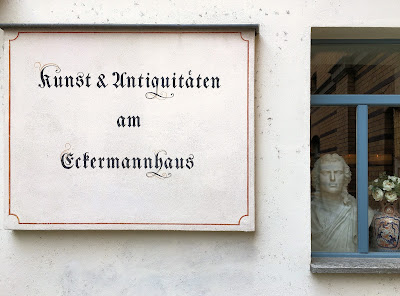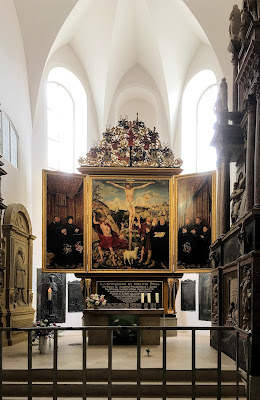Due to family reasons, Red Baron had to shorten his long-awaited trip to Lutherland, i.e., the region in East Germany where Martin Luther initiated the Reformation and started spreading the new religion 500 years ago. So instead of joining my Group at Karlsruhe at 7 a.m. on June 14, I took the train two days later to meet my fellow travelers in Erfurt.
Going by train in Germany is generally smooth, except when changing trains. This time, however, my trouble started earlier. When I asked the waiter for
my traditional pot of coffee and Butterkuchen, he could only serve me a coffee. As compensation and a new experience, I got my connecting train in Fulda this time. As it was already late and not having eaten anything worth mentioning during the day, I went directly to the dining car and ordered a schnitzel with salad.
 |
| Schweineschnitzel with some sort of ratatouille and mixed salad with balsamic dressing |
I terminated my dinner with my favorite
Butterkuchen and an espresso rather than a pot of coffee.
 |
| Butterkuchen in the light of the setting sun. Note the iPad mini that I use when traveling. |
This will be the first blog of a series describing my visit to Lutherland.
The following morning I met my Group for breakfast. The bus took us to Weimar. In the past, I
blogged about essential aspects of Goethe's town several times, so during the present visit, I was looking for new perspectives, although Weimar's reception was something to get used to.
Somewhat perturbed, we passed the
Nationaltheater with the famous statue celebrating the curious friendship between
Goethe and
Schiller.
After the First World War, the place became famous when a German national assembly met at the theater, deliberated, and eventually passed the so-called Weimar Constitution.
 |
The Bauhaus designed the memorial plate
on the left in the photo of the Nationaltheater. |
The next stop on our walking tour was the Bauhaus University, where in the 1920s, among others,
Henry van de Velde, Lyonel Feininger, and
Walter Gropius had worked and taught.
 |
| The river Ilm |
 |
| Visual axis pointing to Weimar's castle tower |
 |
| Weimar castle and castle bridge |
In 1775 the widowed
Duchess of Saxe-Weimar-Eisenach Anna Amalia invited young Goethe (26) to help with the education of her son Carl August (18). When
Carl August became Grand Duke in 1815, he made Goethe his chief adviser. Looking at the duke's statue from 1875, you may recognize Goethe's facial profile, plus showing the educator's tummy.
 |
| Carl August, showing Goethe's facial profile and more |
In April 2012, architect Walter Gropius and femme fatale Alma Mahler-Gropius-Werfel, decorated the Führer's balcony at
the new Elephant Hotel. In October 2012, Henry van de Velde greeted the visitor. This time Martin Luther, who else?, stood there declaring:
Trinken ohne Durst, studieren ohne Lust, beten ohne Innigkeit sind verlorene Arbeit (Drinking without thirst, studying without passion, praying without ardency are labors lost).
During our extended lunch break, I had
the best charcoaled Thüringer Bratwurst in Thuringia at Bianka's. Her secret is: Adding lots of thyme to the stuffing. Later I downed the sausage with a small beer at the
Altweimarische Bierstube, reading at the entrance the famous citation from Goethe's Faust:
Hier bin ich Mensch, hier darf ich's sein! When looking for a translation, Red Baron found the following:
Here I am human, here I am entitled to be!
Here am I human; here I am allowed to be so!
Here I am Man, here dare it to be!
Here I am of humankind; here I am free to be human!
Here I am human; here I may be so!
Here I am human, here I can be it, unhampered!
Make your favorite choice.
In sipping my beer, I enjoyed the view of the Goethehaus.
I spent the beginning of the afternoon at the Bauhaus Museum just opposite the Nationaltheater. On my way, I passed the Eckermannhaus with Schiller looking out the window. During Goethe's last years,
Johann Peter Eckermann served him as secretary.
The exhibition at the Bauhaus Museum shows lots of graphics by Lyonel Feininger. I shall present a typical one in my future blog about Halle.
 |
| Feininger created some untypical houses while working at the Bauhaus in Weimar. |
When leaving the Bauhaus Museum, I noticed a group of students. Most of them I had seen at the exhibition before sitting on the floor and playing with their mobile devices. They continued doing so while standing with their teacher (gray sweater and blue jeans) in front of the building:
O tempora, o mores!
The so-called Herder Church was a building site during my last visit to Weimar. Now, instead of a copy on canvas, the famous allegoric painting describing the new faith was up again in the chancel in time for next year's 500th anniversary of the Reformation.
Lucas Cranach, the Elder, started the painting, but it was finished by his son
Lucas Cranach the Younger.
Outside the church, carriage horses keep Weimar tidy but not their tails.
On our way to Leipzig, our Group passed Naumburg in the afternoon, where we spent two hours at the cathedral. The Naumburger Dom is better known to the layperson for its
Stifterfiguren (founder figures, i.e., the sponsors).
 |
| Smiling, Reglindis greets the visitors. |
 |
| The two Gothic steeples |
The church is dear to all Lutherans. It was here that the first Lutheran bishop
Nikolaus von Amsdorf was consecrated in 1542 in the presence of Martin Luther and the Elector of Saxony,
John Frederick,



























































